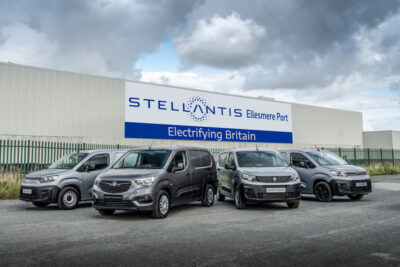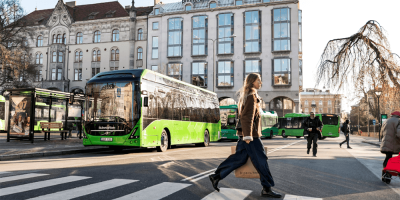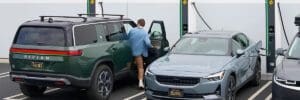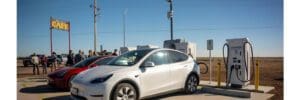
Following the departure of CEO Carlos Tavares, car manufacturer Stellantis wants to rejoin the European manufacturers’ association ACEA. Under Tavares, Stellantis had left the association in 2022.

Following the departure of CEO Carlos Tavares, car manufacturer Stellantis wants to rejoin the European manufacturers’ association ACEA. Under Tavares, Stellantis had left the association in 2022.

The Swedish transport authority Skånetrafiken has just awarded public transport provider Nobina the contract to operate and expand bus services in Malmö for twelve years from June 2027. Nobina has pledged to ensure that 95 per cent of the 300 buses the company operates in Malmo will be electric by 2027, with the rest electrified in the years shortly after.

The Chinese car manufacturer BYD will start production in Europe next year in the compact car segment. According to BYD’s Head of Europe Stella Li, the first two models from Hungary are old acquaintances.
For EV enthusiasts, old hippies, new hippies, and automotive aficionados alike, the 2025 Volkswagen ID Buzz is finally here, marking the triumphant return of our beloved classic bus. Yes, it took nothing short of two entire decades to finally bring this charming concept to market, but we couldn’t be more excited to get inside! So bust out your bell-bottoms, dab some patchouli, and fire up those incense sticks you’ve been stockpiling because the all-new 21st Century Kombi is finally here!
TL;DR: Volkswagen’s all-electric homage to the iconic VW Microbus merges classic nostalgia with an enticing array of modern-day upgrades, making it the freshest, newest face worth talking about in the EV world.
Design and Features
As America’s only all-electric minivan option, the ID Buzz’s design unapologetically embraces its hippy roots. With its upright front end and playful two-tone color schemes, this retro icon is sure to turn heads and pique the interests of EV lovers, petrolheads, and treehuggers alike.
Under the hood (or wherever they put the battery in these things), the ID Buzz promises to pack a lot more punch than its predecessor. No “0-60 in 5 Minutes” bumper stickers here, as 282 horsepower for the rear-wheel-drive version and 335 for the 4Motion model means this little swagger wagon should be more rocketship than minibus. Adding Volkswagen’s suite of advanced driver assistance technologies like IQ.DRIVE and Park Assist Plus with Memory Parking means you’ve got yourself a ride that even the most tech-savvy modern-day hipster would approve of. Sporting a 91-kWh battery, the rear-wheel-drive models boast an EPA-estimated range of 234 miles, while 4Motion all-wheel-drive models are rumored to be good for 231 miles. While neither of these figures provide impressive range, Volkswagen equips both models with a fast-charging lithium-ion battery system, providing users with a +75% charge in just 30 minutes using high-speed chargers.
Hats off to VW interior designers here as well. Inside, you’ll find clean lines, an expansive dash, and an exquisite blend of comfort, storage, and passenger versatility with your choice of three interior themes: dark brown, light brown, or light gray. The classic and chic interior offers just enough retro design cues to make it feel special amidst its industry-leading third-row legroom, a greenhouse-sized 67-inch panoramic glass roof, and several customizable seating arrangements, with options for either second-row bench or captain’s chairs available. In a clever nod to Volkswagen’s first bus, the all-new ID Buzz sports a pair of vintage-style sliding rear windows. Instead of rolling down, the glass simply slides back, just like the originals did. And it’s small touches like these that showcase Volkswagen’s commitment to truly capturing the fun and soul of the original transporter we all know and love. Up front, a 5.3-inch digital cluster and a 12.9-inch infotainment system promise to deliver an enjoyable, seamlessly connected driving experience, especially when paired with the optional 14-speaker Harman Kardon audio package upgrade.
Need more space? Remove the third-row seats and you’ve netted yourself an insane 145.5 cubic feet of party, camping, or pet transporting space, making it perfect for everything from family outings to weekend getaways. Will it have 17, 18, 19 cup holders? We have no idea, but we’d certainly love to see some Westfalia-type companies get ahold of these things for some inspirational high-tech camper conversions, especially in the AWD variants. (We love our vintage Syncro Camper Buses!)
The bad news? It’s definitely the price…
Rolling into dealerships just in time for this year’s Christmakwanzika, the new ID Buzz starts at an eye-watering price of $59,995. At this kind of ask, VW’s transporter can’t really call itself “The People’s Wagon” anymore. And considering the version you really want is going to be the AWD model, expect to drop closer to $68,000 for this enticing little delight. That said, and similar to other launches of retro icons, you can still expect demand to outstrip supply; after all, there’s plenty of man-bun-wearing hipsters out there looking to carve out their social niche. And to be honest, there are probably worse ways to spend seventy grand, but with greedy dealers endlessly trying to cash in on our nostalgia (see your local, friendly Nissan Z dealer for more details), Volkswagen has promised to curb any dealer price gouging. We’ll have to wait and see how that pans out, but it would be nice to not have to pay over MSRP to get your hands on this one.
The 2025 Volkswagen ID Buzz is more than just a new electric vehicle; it’s a revival of a classic vehicle and an equally classic lifestyle that resonates with a whole new generation of drivers while simultaneously bridging the gap with those of us who were around the first time, helping put the original Volkswagen Bus on the map. This new rendition promises to strike a balance between nostalgic appeal and real-world functionality, and while it might not be the perfect vehicle for everyone, it’s sure to capture the hearts of those who appreciate its clever blend of history, innovation, and general functionality.
We’re just glad this thing really finally happened…
Peace!


SOLiTHOR has made advancements in the development of its lithium solid-state batteries, which are designed to help the aviation and maritime industries accelerate their electric transition.
The latest advancements include improvements in cyclability, energy density and readiness for industrialization.
Recent testing of SOLiTHOR’s pouch cells, conducted at a moderate temperature of 25° C and with external pressure below 72 psi/4.9 atm, has resulted in 1,000 full charge discharge cycles with a coulombic efficiency above 99.2 %. The testing measured endurance, which is a key performance requirement for long-lasting aviation and maritime applications.
The company’s thin Gen-1 solid electrolyte combined with thin lithium metal and high-loading nickel-manganese-cobalt (NMC) cathodes enables specific energy of 384 Wh/kg and energy density of 1,026 Wh/l at stack level obtained on a different set of cells. These gravimetric energy values are significant for the aviation and maritime sectors, which require lighter, safer and more powerful batteries.
Relative discharge capacity as a function of number of full cycles for a representative Lithium metal-solid state pouch cell based on NMC / Gen 1 Solid Electrolyte / Li metal components
SOLiTHOR’s solid-state technology is fully compatible with commercial cathode components manufactured in the lithium-ion battery industry. This will enable the rapid industrialization of its products in the coming years by leveraging lithium-ion battery production lines at low cost, according to the company.
SOLiTHOR has manufactured 3 Ah pouch cell prototypes, which it is running through its internal performance and safety testing protocols. Its short-term plan is to send those prototypes for external validation and testing at aviation and maritime manufacturers.
“Aviation and maritime vessels require high power and high energy to provide the necessary electrification to safely transport aircraft and ships over longer distances. One of SOLiTHOR’s long-term objectives is to partner with battery manufacturers to mass-produce the cells for both our aviation and maritime clients,” said Huw Hampson-Jones, the company’s CEO.
Source: SOLiTHOR

US EV startup Rivian plans to launch its first next-generation Rivian Adventure Network charging locations, which allow for non-Rivian electric vehicles to charge alongside the company’s R1T pickup and R1S SUV.
The sites use a new charger design to accommodate any compatible EV in North America. The first site is its Joshua Tree Charging Outpost in California. The company expects to open additional charging locations at sites in Texas, Colorado, Illinois, Montana, Pennsylvania, Michigan and New York.
The chargers will deliver rapid charging at up to 900 V and feature CCS connectors with support for North American Charging Standard (NACS)-equipped vehicles with an automaker-approved adapter. Support for native NACS connectors, also known as SAE J3400, will come with a future hardware update.
The chargers meet the design and siting requirements for federal and state infrastructure funding, allowing Rivian to further expand its charging infrastructure for all EV drivers.
Each charger will also include a larger display and tap-to-pay for use with or without the Rivian mobile app.
“Since the beginning, we’ve understood that creating products like the R1T and R1S only made up half the equation,” said Rivian founder and CEO RJ Scaringe. “To achieve widespread electrification, you also need a good charging network.”
Source: Rivian

The first EV charging station in Texas funded by the National Electric Vehicle Infrastructure (NEVI) Formula Program has opened along Interstate 27 in the rural community of Happy, Texas.
Located in the Texas Panhandle region, the site bolsters EV charging in west Texas and supports interstate travel. The station has four ports, each with a maximum charging speed of 180 kW. Each has both CCS and J3400 connectors.

“The addition of the new NEVI charging station will increase rural charging accessibility and enable uninterrupted EV travel along key travel routes,” said Gabe Klein, Executive Director of the Joint Office of Energy and Transportation.
Rivian: The Underdog Shaping the EV Industry
If you’re following the EV market, you’ve probably noticed Rivian making waves. While Tesla might be the reigning champ, Rivian is quietly and confidently carving its niche. What makes Rivian different? It’s not just about selling electric trucks and SUVs—it’s about creating an experience, building community, and pushing the boundaries of what an EV can do.
Let’s take a closer look at how Rivian is positioning itself to take on the competition.
When Rivian launched its R1T truck and R1S SUV, it wasn’t just selling vehicles—it was selling a lifestyle. These rugged, adventure-ready EVs appeal to people who love exploring the great outdoors. With features like a built-in camp kitchen and impressive off-road capabilities, Rivian vehicles are made for the wild.
This focus on adventure is a stark contrast to Tesla’s sleek, city-focused designs. While Tesla aims for mass appeal, Rivian has zeroed in on a passionate niche: adventurers who want to explore sustainably.
One of Rivian’s boldest moves this year was opening its Adventure Network to all EV owners. Starting with a charging station in Joshua Tree, California, Rivian is expanding this network to 3,500 chargers across 600 locations.
Why does this matter? Because access to charging stations is a major hurdle for EV adoption. By inviting all EV drivers to use its chargers, Rivian is fostering a sense of community and encouraging more people to go electric. It’s a move that sets Rivian apart from Tesla, which only recently began opening select Superchargers to non-Tesla EVs.
Rivian isn’t going it alone. The company has built strong relationships with major players like Amazon and Volkswagen:
These partnerships give Rivian the financial stability and market credibility it needs to grow in a competitive space.
Let’s talk numbers. Rivian’s stock hasn’t had the easiest year, with a year-to-date decline of around 38.4%. However, recent momentum suggests a potential turnaround:
This recent uptick shows that investors still believe in Rivian’s long-term vision.
Rivian’s journey is just beginning. While it has challenges—scaling production, competing with Tesla, and navigating the EV market—it also has massive opportunities. Its focus on a niche market, commitment to sustainability, and innovative partnerships position it as a serious contender in the EV race.
Rivian might not be Tesla, but it doesn’t have to be. The EV market isn’t a zero-sum game, and Rivian is carving out its unique space. Whether you’re an EV enthusiast or just curious about the future of transportation, keep an eye on Rivian. It’s proving that sometimes, the underdog has the most exciting story to tell. Are you ready to see Rivian take on the giants, or are you rooting for the established players? Share your thoughts below!
There are some interesting new cell technologies that have come to market in the last few years, and a few more on their way, that are worth reviewing. Despite their […]
The post OPINION: “Despite small market share, new battery technologies attract great attention” appeared first on Electric & Hybrid Vehicle Technology International.